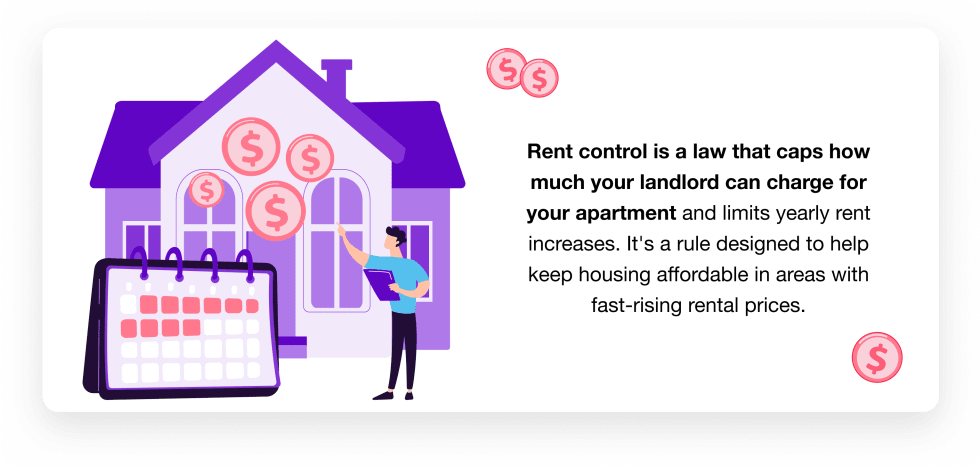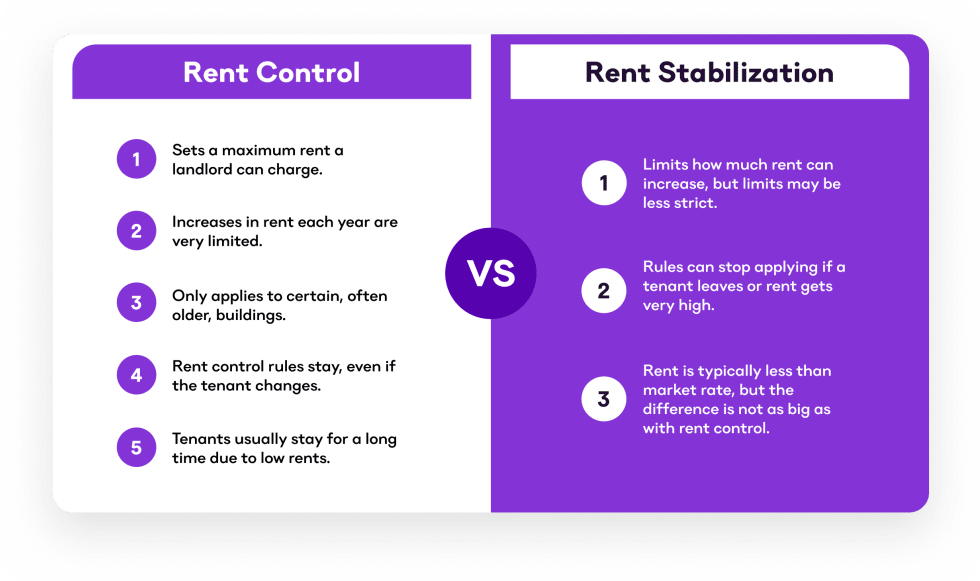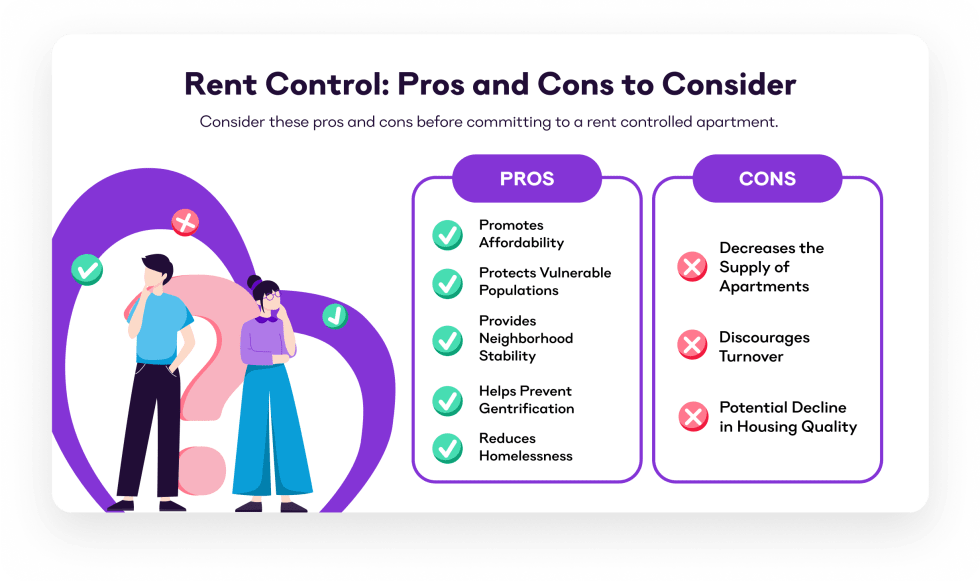The Pembroke
- 111 units available
- 1 bed • 2 bed
- Amenities
In unit laundry, Granite counters, Hardwood floors, Dishwasher, Pet friendly, 24hr maintenance + more

Rent-stabilized and rent-controlled apartments are types of housing regulations designed to protect tenants from sudden or excessive rent increases.
Many renters dream of scoring stable, predictable rent, especially in expensive areas like New York City. Both rent-control and rent-stabilization laws vary widely by region but are generally in place to keep living costs affordable for tenants, especially in areas with high housing costs. They also provide eviction protections, unless the landlord can present a valid reason.
Rent regulations laws can be complex, but they are worth looking into so that you can potentially find a cheaper rent on your next apartment. In this guide, we’ve put together everything you need to navigate rent control and rent stabilization yourself.
Rent control is a government policy that limits how much landlords can increase rent each year. It was created to help renters—especially low-income households—afford stable housing in expensive markets.
However, not every apartment qualifies. Rent control often applies only to older buildings, certain neighborhoods, or units with long-term tenants. Newer buildings, luxury units, and single-family homes are usually exempt.
Despite the relief that rent control offers, it's pretty rare in the U.S. The policy is mostly concentrated in places like New York, New Jersey, California, Washington, D.C., and some parts of Maryland.

Rent control limits how much a landlord can increase rent, but the rules vary by state and city.
For example, in New York City, tenants must have lived in the building continuously since July 1, 1971, in a building constructed before 1947. The leaseholder can also pass down the unit to their children if they lived in the rent-controlled apartment for at least two consecutive years. But when a tenant moves out and their child doesn't request “succession rights,” their rent-controlled apartment can be removed from rent regulations altogether, and a landlord can charge market value.
In Washington, D.C., the rent control law stems from the Rental Housing Act of 1985 and is an annual adjustment. It's based on the Consumer Price Index (CPI-W) increase, which is usually about 2%, but cannot rise more than 10%.
In both Oregon and California, the cap is 10%, and New Jersey’s is 2% to 6% per year. These figures can change, so it's always a good idea to verify the stats if you're looking for a rent-controlled apartment.
There are exceptions to rent control depending on which state or municipality you live in. These exceptions include:
Any rent control ordinance is complex, and you may find some slight variations in your apartment search. For example, D.C. rent control laws dictate that a "small landlord" is when someone owns four units or fewer. If you live in California, single-family, owner-occupied residences where the owner rents no more than two bedrooms or units are exempt. Those rentals could also include an accessory dwelling unit (ADU).
Rent stabilization is a system that limits how much landlords can increase rent each year, while still allowing moderate, predictable raises. Unlike rent control—which freezes or very slowly increases rent for older units—rent stabilization applies to a broader range of apartments and protects tenants from sudden, steep hikes.
The cap is usually tied to inflation or decided by a local housing board. For example, in New York City, the Rent Guidelines board reviews market data annually and sets the percentage (usually between 2.75 - 5.75%) landlords can increase rents for stabilized apartments.
Rent-stabilization works differently depending on the state and city. In New York City, most rent-stabilized apartments are in buildings constructed between 1947 and 1974. They are also primarily found in buildings with six or more units. Each year, the Rent Guidelines Board sets the legal increase, depending on whether you renew for a one- or two-year lease.
California takes a statewide approach through the Tenant Protection Act of 2019 (AB 1482). This law limits annual rent increases for most multi-family properties to 5% plus the local inflation rate, with a hard cap of 10%. Many newer buildings and single-family homes are exempt but for many eligible renters, this law provides a strong measure of predictability.
Oregon was the first state to adopt rent stabilization on a broad scale. Landlords there can raise rent by 7% plus inflation, with the total capped at 10% for 2025.
Other places, like New Jersey, handle rent stabilization at the city level. Cities such as Newark and Jersey City have ordinances that keep annual increases between 2% and 6%. Washington, D.C. also has its own version, tying annual increases to the Consumer Price Index and capping them at 10%.
The terms "rent controlled" vs. "rent stabilized" are often used interchangeably, but they're actually two different things in New York City. “Rent-controlled” units are part of a government program in New York that limits how much a landlord can charge for an apartment or lease renewal. In other states, rent control is basically the same thing as what New York calls rent stabilization — a percentage limit to how much a landlord can raise rent.
There's more to these rent control policies in New York City. The 1970s rent control program prohibits rent increases for one or two years in buildings of six or more units built between February 1, 1947, and December 31, 1973.
The city mayor also appoints a Rent Guidelines Board to set the allowable percentage of how much rent can go up. However, rent in most rent-controlled apartments can only rise up to 3.25% to 5% depending on the length of the lease but cannot exceed a maximum base rent determined per unit.

Both rent-control and rent-stabilization aim to protect tenants from sharp rent increases, but they operate in different ways. Rent-control generally applies to older, long-term units and offers the strictest protections, while rent stabilization is more common and allows modest, predictable annual increases. Here are the pros and cons of each:
The primary benefit of both rent control and rent stabilization is predictable rent. By limiting increases, renters can budget long-term and remain in expensive cities that might otherwise be unaffordable. Stabilized rents, in particular, help middle-income renters manage costs in competitive markets.
Elderly tenants, people with disabilities, and families on fixed incomes often rely on these protections to avoid displacement. With both rent control and stabilization, tenants don’t have to fear sudden, destabilizing rent hikes.
Benefits of rent control and stabilization include making neighborhoods safer by fostering a sense of community with long-term renters and lower turnover. With less turnover, renters are more likely to get to know their neighbors and get socially involved.
Gentrification is a problem in almost every major city in the US. It happens when a characteristically poor or inexpensive urban area is changed by wealthier people moving in, whether it’s an apartment or business. The results displace longtime residents, who are forced to move on after a rent hike that reflects the changes in the neighborhood. Rent stabilization is great for middle-income renters, while strict rent control is essential for lower-income households.
Rent regulation laws can be a lifeline in cities with a dramatic increase in people experiencing homelessness. Instead of facing rent increases that someone can't afford and being forced onto the streets, stable rent keeps them in their homes.

Because tenants tend to hold onto rent-regulated apartments, fewer units become available to new renters. Developers may also hesitate to build new rental housing in cities with strong rent regulations, fearing lower returns. This can cause a lack of housing options for people moving in.
It's common to hear stories about rent-controlled and stabilized apartments in lousy shape and in need of desperate repairs. Whether landlords don't want to deal with their units or feel it's too expensive to fix them, the quality of existing rentals can plummet.
Rent-regulated apartments turn over at a snail's pace and often leave renters with mismatched needs. For example, a family could continue living in a studio apartment because the rent is stable. Or an older couple whose children have grown up and moved away may live in a family-sized unit and be afraid to downsize and lose their protections. This mismatch reduces housing flexibility for the broader rental market.
Complex and Inconsistent Rules
Rent control and stabilization laws vary significantly from city to city and state to state. Understanding eligibility, exemptions, and allowable increases often requires navigating complicated regulations. This makes the system confusing for both renters and landlords.
Uneven Benefits
While some tenants gain significant protections, others may never access these units because of low turnover and limited supply. Rent stabilization tends to benefit more households overall than strict rent control, but availability is uneven.
Rent control and rent stabilization laws are complex and have their share of drawbacks, but they're still highly-sought-after by renters. You can look for your own rent-regulated apartment, but you'll need to stay diligent and exercise persistence to find one and hold on to it. It's also vital to check the latest figures and stats, as rent-control and rent-stabilization rules can quickly change.
Ready to find an apartment that fits your budget? Sign up for Apartment List to find the ideal place for you. With us, you’ll spend 5 minutes and save 50 hours searching.
In California and Oregon, most newer multifamily units are rent stabilized.
You can try sites like AmIRentStabilized.com to find info, although not all cities keep their public government listings up to date. Asking around by word-of-mouth or filling out an online inquiry with New York State here will yield better results.
If you live in Oregon or California, either local municipalities or the state government determines rent control rules. In New York, the city mayor appoints a Rent Guidelines Board to set the rent policy and how much rent can rise.
The amount a landlord can raise rent depends on where you live and whether the building is rent-controlled or rent-stabilized. In most states, there is no limit to how much a landlord can raise the rent.
However, in states with rent control like Oregon, the new cap is 14.6%. In California, it's 10%; in New York City it is 3.25% to 5%; and in most parts of New Jersey, it’s 2% to 6%. There are some universal exceptions if you're a disabled or elderly renter.



In unit laundry, Granite counters, Hardwood floors, Dishwasher, Pet friendly, 24hr maintenance + more
In unit laundry, Patio / balcony, Granite counters, Pet friendly, Stainless steel, Walk in closets + more